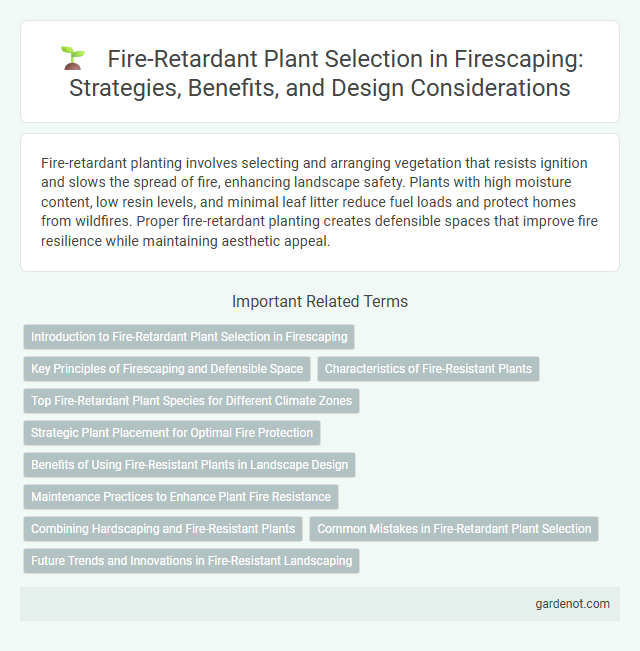Fire-retardant planting involves selecting and arranging vegetation that resists ignition and slows the spread of fire, enhancing landscape safety. Plants with high moisture content, low resin levels, and minimal leaf litter reduce fuel loads and protect homes from wildfires. Proper fire-retardant planting creates defensible spaces that improve fire resilience while maintaining aesthetic appeal.
Introduction to Fire-Retardant Plant Selection in Firescaping
Fire-retardant plant selection in firescaping emphasizes choosing species with high moisture content, low resin or oil levels, and minimal dead material that reduce ignition risk and slow fire spread. Plants such as succulents, herbaceous perennials, and hardwoods with thick leaves enhance landscape resilience against wildfires. Incorporating fire-resistant vegetation around homes creates defensible space, lowers property damage potential, and supports wildfire management strategies.
Key Principles of Firescaping and Defensible Space
Fire-retardant planting emphasizes the selection of low-flammability plants that retain high moisture content to reduce wildfire fuel loads near structures. Key principles of firescaping include maintaining proper spacing between plants, removing dead vegetation, and creating defensible space zones that allow firefighters to protect homes more effectively. Defensible space involves clearing a minimum of 30 feet around buildings, prioritizing drought-resistant, fire-resistant species to interrupt fire spread and enhance landscape resilience.
Characteristics of Fire-Resistant Plants
Fire-resistant plants typically possess thick, moisture-rich leaves that reduce flammability and slow combustion, such as succulents and broadleaf evergreens. These plants often have low oil and resin content, minimizing the release of volatile compounds that fuel fires. Their ability to retain high water content, coupled with sparse accumulation of dead material, makes them effective natural firebreaks in firescaping designs.
Top Fire-Retardant Plant Species for Different Climate Zones
Top fire-retardant plant species vary by climate zone, with Agapanthus and Aloe Vera thriving in Mediterranean climates due to their thick, water-storing leaves that resist ignition. In arid zones, succulents like Sedum and Aeonium exhibit high fire resistance, reducing flame spread through their moisture-rich tissues. Coastal regions benefit from fire-safe species such as the California Lilac (Ceanothus) and Kangaroo Paw (Anigozanthos), which maintain low flammability and create natural firebreaks.
Strategic Plant Placement for Optimal Fire Protection
Strategic plant placement enhances fire retardance by creating defensible spaces that reduce fuel availability near structures. Utilizing fire-resistant species with high moisture content, such as succulents and carefully spaced shrubs, slows fire spread and limits heat intensity. Proper layering of vegetation and maintaining clear zones around buildings significantly improve overall fire protection and landscape resilience.
Benefits of Using Fire-Resistant Plants in Landscape Design
Fire-resistant plants reduce the risk of wildfires by slowing fire spread and minimizing fuel availability, enhancing landscape safety. These plants typically have high moisture content, low resin, and minimal dead material, which helps protect homes and property. Incorporating fire-retardant vegetation in landscape design supports fire prevention strategies and promotes environmental resilience.
Maintenance Practices to Enhance Plant Fire Resistance
Regular pruning and removal of dead or dry foliage significantly reduce fuel load, enhancing plant fire resistance in firescaping. Applying appropriate irrigation techniques maintains plant moisture levels, which slows combustion and prevents rapid fire spread. Using mulch sparingly and selecting fire-resistant plant species further supports long-term fire-retardant landscapes by minimizing flammable material accumulation.
Combining Hardscaping and Fire-Resistant Plants
Combining hardscaping with fire-resistant plants enhances fire-retardant landscaping by creating physical barriers that slow fire spread and reduce combustible material near structures. Materials such as gravel, stone pathways, and concrete patios help isolate fire-resistant species like succulents, lavender, and agave, decreasing overall fire risk. Strategic placement of these elements improves defensible space, increasing property protection during wildfire events.
Common Mistakes in Fire-Retardant Plant Selection
Choosing plants with high resin or oil content, such as eucalyptus or pine, undermines fire-retardant landscaping goals due to their flammability. Overlooking plant maintenance leads to accumulated dead foliage and dry material, increasing fire risk despite fire-resistant species. Selecting plants without considering their fire behavior in mature size or seasonal changes results in unexpected flammability during peak fire seasons.
Future Trends and Innovations in Fire-Resistant Landscaping
Fire-retardant planting is evolving with advancements in drought-tolerant, fire-resistant plant species engineered for enhanced flame resistance and reduced combustibility. Integration of smart irrigation systems and sensor-driven moisture management optimizes plant hydration, minimizing fire risk in landscapes. Emerging innovations in genetic research and eco-friendly fire retardants are poised to revolutionize sustainable, fire-resilient garden designs.
Fire-retardant planting Infographic

 gardenot.com
gardenot.com